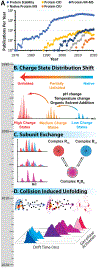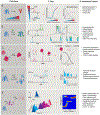Mass Spectrometry Methods for Measuring Protein Stability
- PMID: 35316030
- PMCID: PMC9197173
- DOI: 10.1021/acs.chemrev.1c00857
Mass Spectrometry Methods for Measuring Protein Stability
Abstract
Mass spectrometry is a central technology in the life sciences, providing our most comprehensive account of the molecular inventory of the cell. In parallel with developments in mass spectrometry technologies targeting such assessments of cellular composition, mass spectrometry tools have emerged as versatile probes of biomolecular stability. In this review, we cover recent advancements in this branch of mass spectrometry that target proteins, a centrally important class of macromolecules that accounts for most biochemical functions and drug targets. Our efforts cover tools such as hydrogen-deuterium exchange, chemical cross-linking, ion mobility, collision induced unfolding, and other techniques capable of stability assessments on a proteomic scale. In addition, we focus on a range of application areas where mass spectrometry-driven protein stability measurements have made notable impacts, including studies of membrane proteins, heat shock proteins, amyloidogenic proteins, and biotherapeutics. We conclude by briefly discussing the future of this vibrant and fast-moving area of research.
Figures








Similar articles
-
Collision Cross Sections for Native Proteomics: Challenges and Opportunities.J Proteome Res. 2022 Jan 7;21(1):2-8. doi: 10.1021/acs.jproteome.1c00686. Epub 2021 Nov 30. J Proteome Res. 2022. PMID: 34846899 Free PMC article.
-
Modern mass spectrometry-based structural proteomics.Adv Protein Chem Struct Biol. 2014;95:193-213. doi: 10.1016/B978-0-12-800453-1.00006-3. Adv Protein Chem Struct Biol. 2014. PMID: 24985773
-
Proteome-Wide Structural Biology: An Emerging Field for the Structural Analysis of Proteins on the Proteomic Scale.J Proteome Res. 2018 Nov 2;17(11):3614-3627. doi: 10.1021/acs.jproteome.8b00341. Epub 2018 Oct 8. J Proteome Res. 2018. PMID: 30222357 Free PMC article. Review.
-
Measurement and utilization of the proteomic reactivity by mass spectrometry.Mass Spectrom Rev. 2024 Jan-Feb;43(1):166-192. doi: 10.1002/mas.21837. Epub 2023 Mar 16. Mass Spectrom Rev. 2024. PMID: 36924435 Review.
-
[Progress in structural proteomics research].Se Pu. 2019 Aug 8;37(8):788-797. doi: 10.3724/SP.J.1123.2019.04015. Se Pu. 2019. PMID: 31642248 Review. Chinese.
Cited by
-
Conformational Landscapes and Energetics of Carbon Nanohoops and their Ring-in-Ring Complexes.J Phys Chem Lett. 2024 Jul 4;15(26):6805-6811. doi: 10.1021/acs.jpclett.4c01270. Epub 2024 Jun 24. J Phys Chem Lett. 2024. PMID: 38913548 Free PMC article.
-
An ion mobility-mass spectrometry study of copper-metallothionein-2A: binding sites and stabilities of Cu-MT and mixed metal Cu-Ag and Cu-Cd complexes.Analyst. 2023 Jan 31;148(3):546-555. doi: 10.1039/d2an01556k. Analyst. 2023. PMID: 36545796 Free PMC article.
-
Disassembly Mechanisms and Energetics of Polymetallic Rings and Rotaxanes.J Am Chem Soc. 2022 Dec 14;144(49):22528-22539. doi: 10.1021/jacs.2c07522. Epub 2022 Dec 2. J Am Chem Soc. 2022. PMID: 36459680 Free PMC article.
-
Monitoring host-pathogen interactions using chemical proteomics.RSC Chem Biol. 2023 Nov 10;5(2):73-89. doi: 10.1039/d3cb00135k. eCollection 2024 Feb 7. RSC Chem Biol. 2023. PMID: 38333198 Free PMC article. Review.
-
Effects of Nano-Electrospray Ionization Emitter Position on Unintentional In-Source Activation of Peptide and Protein Ions.J Am Soc Mass Spectrom. 2024 Mar 6;35(3):498-507. doi: 10.1021/jasms.3c00371. Epub 2024 Feb 19. J Am Soc Mass Spectrom. 2024. PMID: 38374644 Free PMC article.
References
Publication types
MeSH terms
Substances
Grants and funding
LinkOut - more resources
Full Text Sources
Other Literature Sources

